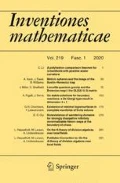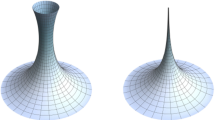Abstract
We calculate a wall crossing formula for 4-dimensional Poincaré–Einstein metrics, through a wall made of orbifold Poincaré–Einstein metrics with \(A_1\) singularities. This is based on a formalism which enables to deal with higher order terms of the Einstein equation in this setting. Some other consequences are deduced.
Similar content being viewed by others
Notes
Il y a une faute de frappe dans le système analogue (103) de [4], où le terme d’erreur est seulement en \(O(r^2)\), ce qui laisse subsister une ambiguïté sur les coefficients \(\mu \); le contrôle \(O(r^\epsilon )\) est nécessaire pour obtenir un recollement suffisamment bon de la métrique \(\mathbf {g}+th+t^2h_2\) sur Y avec \(g_0\).
References
Anderson, M.T.: Einstein metrics with prescribed conformal infinity on 4-manifolds. Geom. Funct. Anal. 18(2), 305–366 (2008)
Besse, A.L.: Einstein Manifolds. Springer, Berlin (1987)
Biquard, O.: Métriques d’Einstein asymptotiquement symétriques. Astérisque 265, vi+109 (2000). (English translation: SMF/AMS Texts and Monographs 13, 2006)
Biquard, O.: Désingularisation de métriques d’Einstein. I. Invent. Math. 192(1), 197–252 (2013)
Biquard, O., Gauduchon, P.: Hyper-Kähler metrics on cotangent bundles of Hermitian symmetric spaces. In: Geometry and Physics (Aarhus, 1995), pp. 287–298. Dekker, New York (1997)
Fine, J.: A gauge theoretic approach to the anti-self-dual Einstein equations. arXiv:1111.5005 (2011)
Graham, C.R., Lee, J.M.: Einstein metrics with prescribed conformal infinity on the ball. Adv. Math. 87(2), 186–225 (1991)
Hitchin N.: Integrable systems in Riemannian geometry. In: Surveys in Differential Geometry: Integrable Systems. Surveys in Differential Geometry, vol. 4, pp. 21–81. International Press, Boston (1998)
Kronheimer, P.B.: The construction of ALE spaces as hyper-Kähler quotients. J. Differ. Geom. 29(3), 665–683 (1989)
Lee, J.M.: Fredholm operators and Einstein metrics on conformally compact manifolds. Mem. Am. Math. Soc. 183(864), vi+83 (2006)
Author information
Authors and Affiliations
Corresponding author
Additional information
L’auteur bénéficie du soutien du projet ANR-10-BLAN 0105.
Annexe: Les instantons \(A_k\)
Annexe: Les instantons \(A_k\)
Dans cette annexe, nous donnons rapidement les formules explicites utilisées sur les instantons gravitationnels de type \(A_k\). Commençons par rappeler l’ansatz de Gibbons–Hawking.
Soit V une fonction harmonique sur \(\mathbb {R}^3\), telle que \(*dV=d\eta \), où \(\eta \) est la 1-forme de connexion d’un fibré en cercles (ce qui exige que la classe de cohomologie de la forme fermée \(\frac{*dV}{2\pi }\) soit entière). Alors, sur l’espace total du fibré, la formule
définit une métrique hyperkälérienne, pour laquelle \(J_1dx^1=V^{-1}\eta \) et \(J_1dx^2=dx^3\), et \(J_2\) et \(J_3\) sont définies de manière similaire par permutation circulaire sur \((x^1,x^2,x^3)\).
Les instantons gravitationnels de type \(A_k\) sont obtenus en prenant
sur \(\mathbb {R}^3-\{p_i\}\), où les \(p_i\) sont des points distincts de \(\mathbb {R}^3\). Compte tenu de l’invariance par translation, on peut supposer
En ajoutant un point au-dessus de chaque \(p_i\), on peut montrer que la métrique s’étend en une métrique lisse. Quand certains \(p_i\) sont confondus, on obtient une singularité orbifold. Le cas de rang 1 avec une seule singularité orbifold restante correspond à k points confondus, \(p_1=\cdots =p_k\). Vu l’action de \(SO_3\) sur la situation, on peut supposer ces points situés sur l’axe des \(x^1\), et donc
Alors on a une singularité \(A_{k-1}\) au point \(p_1\), et la courbe \(J_1\)-holomorphe \(\Sigma \) se trouve au-dessus du segment \([p_0,p_1]\). En particulier,
Notons \(\rho \) le rayon dans \(\mathbb {R}^3\) et r le rayon dans \(\mathbb {R}^4\). Vu que \(V\sim \frac{k+1}{2\rho }\), on obtient à l’infini, en prenant \(r^2=2(k+1)\rho \),
qui est la métrique standard de \(\mathbb {R}^4/\mathbb {Z}_{k+1}\).
La situation est invariante par les rotations en les coordonnées \((x^2,x^3)\), qui donne l’action de cercle cherchée (il faut prendre une action de poids 2, par \(e^{2i\theta }(x^2+ix^3)\), car les \(x^i\) sont quadratiques en les coordonnées de \(\mathbb {R}^4\)). L’application moment m est
et \(\frac{m}{2}\) est un potentiel pour \(\omega _2\) et \(\omega _3\). On observera que, comme il se doit, \(m\sim (k+1)\rho \sim \frac{r^2}{2}\). En particulier, on déduit la formule utilisée dans la démonstration du lemme,
Enfin, une des vertus de l’ansatz de Gibbons–Hawking est de fournir les fonctions harmoniques \(x^i\). On calcule facilement le développement
Il en résulte que la fonction harmonique \(\varphi _1\) dans la démonstration du Lemme 5 n’est autre que
En particulier, le calcul fait dans ce lemme est justifié par la formule
Rights and permissions
About this article
Cite this article
Biquard, O. Désingularisation de métriques d’Einstein. II. Invent. math. 204, 473–504 (2016). https://doi.org/10.1007/s00222-015-0619-3
Received:
Accepted:
Published:
Issue Date:
DOI: https://doi.org/10.1007/s00222-015-0619-3



